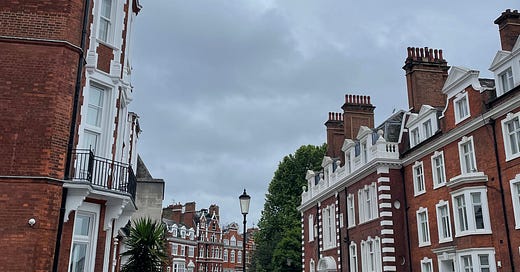Hello and welcome to this week’s edition of The Bell! Thanks to my lovely husband for forwarding the email that sparked today’s topic.
Down in Oklahoma City, a quiet revolution is happening. A young man named Austin Tunnell, builder-turned-real-estate-developer, runs a company called Building Culture that creates architecture “to promote human flourishing.”
“That means more than quality construction using durable materials. To endure for centuries, buildings must stir the soul, inviting attention, love and affection.”
As you know by now if you’ve been reading this newsletter for a while, I couldn’t agree more.
Buildings that are made of quality, lasting materials, architecture that has beauty and sense of place and uniqueness and human scale… not much of that is getting built in America. But in Oklahoma City, Tunnell and his company are leading the charge.
He sent an email the other day (that inexplicably isn’t published on his website so I can’t link it) that was primarily about investment syndication and how it works. But he spent some time on why syndication is key to building the kinds of neighborhoods and cities we actually want to live in—and want to hand down to our children and grandchildren.
Syndication is, essentially, the ability for a developer without deep pockets to identify, lead, and take responsibility for a project that fits their values of real estate development. Through recruiting multiple investors who share the same values, the developer can complete the project.
It’s a little more complicated than that, of course—and we owe the simple legal ability to do syndication in real estate to the JOBS Act of 2012, under the Obama administration, that eased many of the country’s securities regulations to encourage funding of small businesses in the United States.
Syndication isn’t just for those wanting to build lasting, quality, beautiful architecture. You can also use syndication to gather investors and put up as much cheap, easy, cookie cutter architecture as you want.
But there are other, easier ways to go the easy route: there are massive funds whose entire purpose is to build cookie cutter buildings as financial products. Anyone is free to invest in those.
But without syndication, you can’t build buildings “the hard way” (the quality, lasting way) unless you’re very, very, very wealthy.
For another day: a newsletter detailing all the reasons why building buildings the hard way is worthwhile. I touched on it here, when writing about Brent Hull, another important player in this movement. (That article was the one that made me change the whole direction of my newsletter.)
But for today: it’s on my mind that most things are better when you do them the hard way, rather than taking the easy route, including:
Relationships
Parenting
Personal growth and the examined life
Facing reality
Feeling your feelings
Fitness
Flexibility and mobility
Eating
Earning money
Growing a garden—or growing your own food
Developing a skill
Making coffee
Baking and cooking homemade
Shopping at the farmer’s market
What would you add?
If we invest time, energy, money, and more in building relationships that last a lifetime, a healthy body that will carry us into old age, a garden that bears fruit, and a fulfilling career…
…Why do we settle for letting real estate developers backed by faceless corporate money take the easy way out when building our homes and our cities?
Our communities are our own responsibility. Austin Tunnell and his colleagues are bravely taking responsibility for the future of Oklahoma City and building the community they want to live in and leave to their children. I’ll leave you with his words:
The last time people made human flourishing and beauty their ideal, it birthed the Renaissance, resulting in cities like Florence, home to some of the most beautiful and enduring architecture ever built. As a society we spend billions to experience these places for a week—yet when we return home we simply accept modern America’s throwaway building culture, mumbling the oft-repeated line: "We don’t build things like we used to."
What's stopping us?
It’s hard, that’s what. The buildings go up slower. It’s harder to find the skills and materials, and you have to pay more for them. The returns for the investors may not flow in as quickly. But living in a community, we’re investing in more than just our own individual flourishing. When the water rises, all boats float.
Let me know your thoughts.
xx Jane




